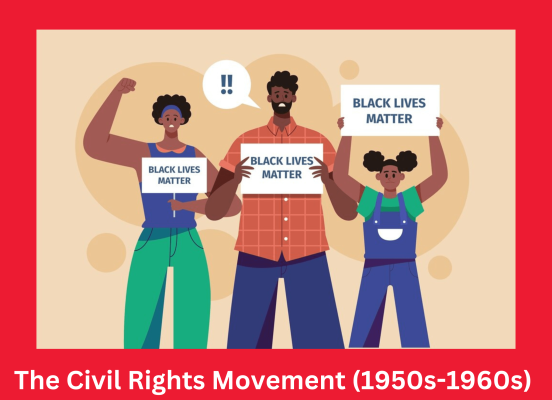
The Civil Rights Movement (1950s-1960s) - A series of social movements advocating for equal rights and treatment of African Americans in the United States
- By admin --
- Tuesday, 12 Mar, 2024
A pivotal period in American history, the Civil Rights Movement of the 1950s and 1960s was characterized by a valiant fight for justice, equality, and human dignity. The movement, which began in the years following World War II, was a grassroots revolt against the institutionalized racism, discrimination, and racial segregation that characterized American culture, especially in the southern states. Under the direction of visionary leaders like Martin Luther King Jr., Rosa Parks, and Malcolm X, and with the help of innumerable common people, the Civil Rights Movement changed the nation's conscience and the trajectory of American democracy.
Fundamentally, the goal of the Civil Rights Movement was to remove the social and legal restrictions that denied African Americans equal citizenship rights and access to opportunities that were available to their white counterparts. Segregationist laws and practices, which restricted African Americans to subpar public amenities, employment opportunities, housing, and educational opportunities, were a tangible example of these deeply ingrained obstacles in American culture.
The National Association for the Advancement of Colored People (NAACP) and the Southern Christian Leadership Conference (SCLC), two African American leaders and organizations, established the foundation for the ensuing struggle during the early decades of the 20th century, which is when the Civil Rights Movement first began.
The landmark Supreme Court decision in Brown v. Board of Education in 1954, which declared segregation in public schools unconstitutional, provided a legal and moral impetus for the movement's momentum.
During the 1950s, the Civil Rights Movement saw significant growth and exposure due to a number of important campaigns and events that attracted national attention and inspired popular support. The Montgomery Bus Boycott of 1955–1956 was started by Rosa Parks’s stubbornness not to surrender her seat to a white passenger thus effectively demonstrating the ability of passive resistance and collective action in challenging segregationist policy.
After seeing how much of a success the Montgomery Bus Boycott was, this made Martin Luther King Jr. become a significant person during the Civil Rights Movement. He promoted peaceful protest and civil disobedience as strategies for bringing about social change. King moved millions of Americans through his influential speeches; one of these is the famous “I have a dream” speech that he gave at The March on Washington for Jobs and Freedom in 1963. These speeches also served to galvanize support for the movement's objectives.
The civil rights movement was in full swing in the 60s. In a bid to stop segregation and clamor for fairness, black Americans alongside other supporters organized lots of demonstrations including mass protests and road trips to different parts of the country. The brutality of Selma, Alabama on marchers during 1965 and other brutal attacks on nonviolent demonstrators showed that racial hatred and discrimination still persisted in the South.
Militant voices that advocated for more drastic measures to oppose ingrained racism and white supremacist began to surface throughout the Civil Rights Movement. People like Malcolm X, a fiery orator and proponent of black nationalism, and the Black Panther Party, which encouraged community empowerment and armed self-defense, offered alternative perspectives on African American liberation and empowerment. Militant voices in the Civil Rights Movement started to emerge, calling for more violent tactics to combat systemic racism and white supremacist ideology. Alternative views on African American emancipation and empowerment were given by people such as Black Panther Party that encouraged community empowerment besides armed self-defense, and also Malcolm X who was a vibrant speaker that supported black nationalism.
In the presence of significant hardships and resistances, advocates of civil rights kept pushing in their fight for fairness and parity. All arose from their sweat were The Civil Rights Act of 1964 which outlawed discrimination based on race, color, religion, sex or national origin and The Voting Rights Act of 1965 making illegal racial discrimination against persons who exercised their franchise in various ways.
Although these historic legislation marked important turning points in the fight for racial justice and equality in America, the civil rights movement was far from ended. Martin Luther King Jr.'s 1968 killing and ongoing incidents of racial violence and prejudice served as sobering reminders of the persistent obstacles African Americans face in their pursuit of equality and full citizenship.
In addition, Massive social and political movements for justice and equality like environmental justice, girls’s and LGBTQ rights re some of the moves that resulted and drew their motivation from the Civil Rights Movement. Today, Civil Rights Movement’s impact continues via the battle by way of activists and supporters in opposition to institutional racism, financial disparity, and social injustice in all its forms.
As the country considers the Civil Rights Movement's history, we owe it to the brave individuals who battled for equality and justice to celebrate their accomplishments and sacrifices. Human rights battles should never cease; thus, we need to be watchful, united and devote ourselves to promoting democratic principles as well as individual freedoms. It is important for us to acknowledge our history through embracing some aspects of the Civil Rights Movement which will enable us build an all-inclusive world where everyone accesses justice and enjoys liberty.





